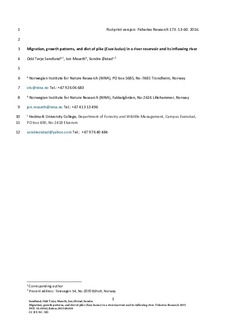| dc.description.abstract | The pike population in the Løpsjøen reservoir and the accessible 21 km section of the inflowing RiverRena was investigated from 2003 to 2013. Telemetry and mark-recapture with Floy tags demonstratedthat most fish had an annual home range of less than 2 km, while some fish performed quite extensivemigrations (up to 14.4 km). Of fish radio-tagged in the reservoir, 57% were positioned in the river atleast once. The population of pike ≥25 cm was estimated at 1002 fish, or 3.9 fish (3.17 kg) ha−1. Meanlength at age was significantly larger for pike caught in the river than in the reservoir for almost all agegroups. CPUE during boat electro-fishing indicated significantly lower population densities and a lowerproportion of juvenile fish in the river than in the reservoir. Diet analysis revealed that almost all availableprey fish species were taken by pike, and that there was a clear diet differentiation between pike sizeclasses, and between fish from the river and reservoir habitats. Small pike (<25 cm) in the reservoir hadeaten mainly invertebrates, whereas smaller pike and Alpine bullhead (Cottus poecilopus) dominated insmall pike from the river. Nine prey fish species were identified in the stomachs of medium sized pike(25–50 cm) in the reservoir, with brook lamprey (Lampetra planeri) and brown trout (Salmo trutta) asdominant. Medium sized pike in the river had taken mainly lamprey and Alpine bullhead. Larger pike(>50 cm) in the reservoir had taken brown trout as well as a number of other prey fish, while river pike ofthis size had taken burbot (Lota lota), lamprey and brown trout. Species like perch (Perca fluviatilis), roach(Rutilus rutilus) and in particular grayling (Thymallus thymallus) were rarely found in pike stomachs. Theconstruction of the reservoir in a fast-flowing river caused the establishment of a healthy pike populationand additional predation pressure on the rheophilic salmonids in the system, both in the reservoir andin the inflowing river.© 2015 Elsevier B.V. All rights reserved. River fragmentation, Predation, Habitat utilization, Habitat modification, Northern pike | |
